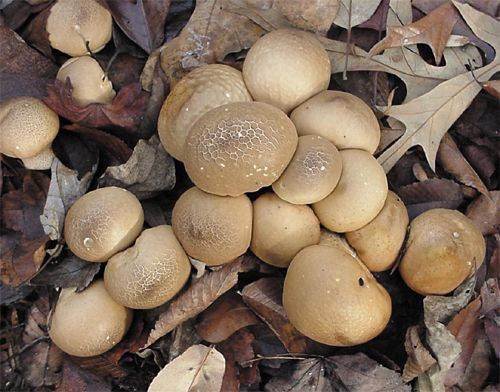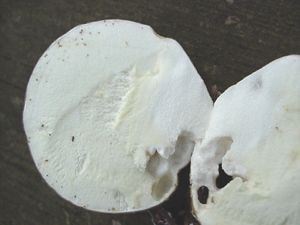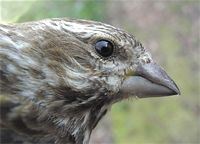 HOME: www.hiltonpond.org |
|
||
|
|
|||
|
|
|||
|
|
|||
|
|
|||
|
|
|||
|
|
THIS WEEK at |
|
PUFFBALLS Although we're still 'way below normal for annual precipitation at Hilton Pond Center, we've had a couple of soaking one-inch rainfalls in the past three weeks. That didn't make much of an impact on water levels in Hilton Pond, but it did awaken a "sleeping giant." The giant doesn't stand very tall, but it is quite wide, and there was no indication it was even in our neighborhood until the long overdue moisture caused it to stir.  What we're talking about here is the awakening of a "mycelium"--a subterranean network of root-like structures--that, when conditions are ripe, gives rise to what we commonly call a "mushroom." The mycelium, itself made of tiny white thread-like hyphae (below right), is the vegetative stage of a mushroom, and it spends the majority of its life in some dark place, secreting enzymes that break down wood or other organic material. Then, when conditions are right, the hyphae quickly form its distinctive aboveground reproductive structure--the mushroom. Puffballs aren't shaped like a typical mushroom that has a central column topped of with a more-or-less flattened cap. Instead, a puffball is typically a spherical or ovoid mass that in some species may be larger than a watermelon. At Hilton Pond Center, our Pear-shaped Puffballs (top photo) are considerably smaller than this, the largest individuals measuring only about two inches in height and diameter. Pear-shaped Puffballs are widely distributed across North America and typically grow on old logs or well-rotted lumber.
One interesting sidelight about the Pear-shaped Puffball is the origin of its scientific name, Lycoperdon pyriforme, which demonstrates that even mycologists--i.e., mushroom specialists--must have a sense of humor (however warped it may be). The name "pyriforme" comes from Latin words meaning "pear" and "shaped"; given the common name, this is not a surprising epithet. But "Lycoperdon" comes from the words for "wolf" and "to break wind." We suppose the latter is a play on words--in that puffballs release their spores in a flatulent sort of way--but where the wolf comes in we're not sure, unless the mycologist who named this fungus ate a few too many magic mushrooms and imagined that the sound of a puffball puffing was like that of a wolf passing gas in the woods. Sorry to seem so scatological, but we felt like we needed to share as much information as we could about Pear-shaped Puffballs. Besides, you just never know when some TV game show host is going to ask you what "Lycoperdon" really means. If you enjoy "This Week at Hilton Pond," please help Support Hilton Pond Center for Piedmont Natural History. It's painless, and YOU can make a difference! You may wish to consult our Index of all nature topics covered since February 2000. |

 If the mycelium is truly gigantic--and it may spread for hundreds of square feet just beneath the surface of the forest floor--dozens of mushrooms can pop up overnight. Such was the case this week when multiple colonies of Pear-shaped Puffballs shot up from a layer of wood chips we scattered on one of our trails last winter.
If the mycelium is truly gigantic--and it may spread for hundreds of square feet just beneath the surface of the forest floor--dozens of mushrooms can pop up overnight. Such was the case this week when multiple colonies of Pear-shaped Puffballs shot up from a layer of wood chips we scattered on one of our trails last winter. Their thread-like hyphae are white and produce a small tan-colored button that may grow into a three-inch sphere that may or may not have a short stalk. Early on, the sphere is filled with white, fleshy material that is edible (left), but its color soon changes to olive-green and then brown as spores are produced internally (below right). Eventually, the rubbery outside covering dries out and either disintegrates or forms a small apical opening. When the mature fungus is bumped, clouds of spores are blown out through the hole, hence the name "puffball."
Their thread-like hyphae are white and produce a small tan-colored button that may grow into a three-inch sphere that may or may not have a short stalk. Early on, the sphere is filled with white, fleshy material that is edible (left), but its color soon changes to olive-green and then brown as spores are produced internally (below right). Eventually, the rubbery outside covering dries out and either disintegrates or forms a small apical opening. When the mature fungus is bumped, clouds of spores are blown out through the hole, hence the name "puffball." Even a small puffball can produce millions of spores, each of which has the potential to germinate and form a new hyphal thread that, over time, divides and multiplies into a much larger mycelium. This winter, look for Pear-shaped Puffballs on fallen logs. By then they'll probably be dark brown in color, but they'll be filled with mature spores that will spew forth almost magically if you tap gently on the side of the fungus.
Even a small puffball can produce millions of spores, each of which has the potential to germinate and form a new hyphal thread that, over time, divides and multiplies into a much larger mycelium. This winter, look for Pear-shaped Puffballs on fallen logs. By then they'll probably be dark brown in color, but they'll be filled with mature spores that will spew forth almost magically if you tap gently on the side of the fungus.


